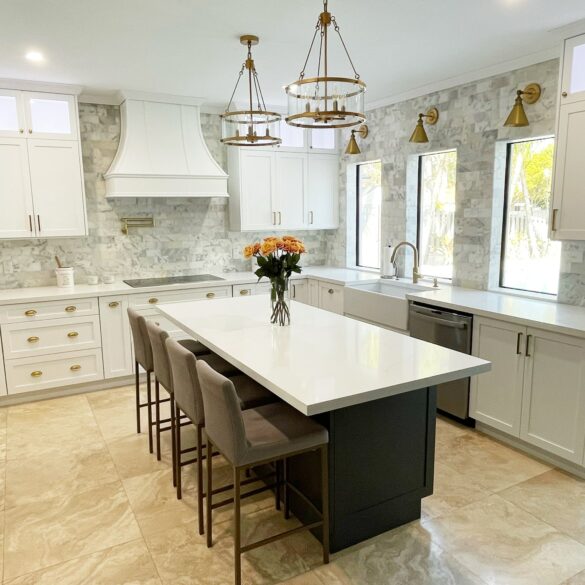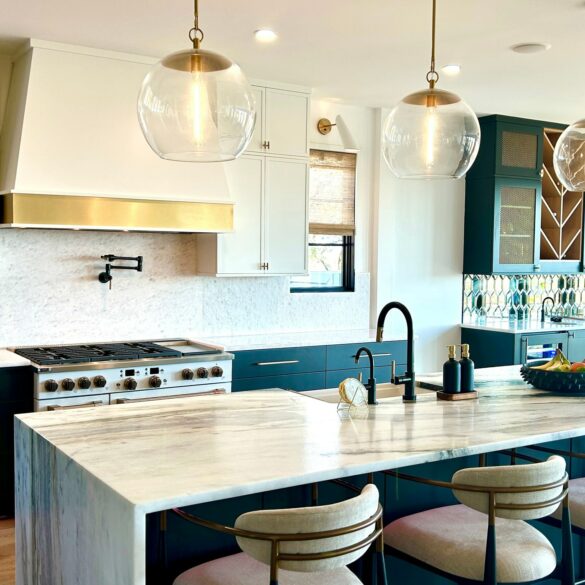Congratulations on your decision to add a kitchen island design to your culinary haven. A well-designed kitchen island holds the potential to transform your kitchen into a versatile and stylish space. Whether it’s catering to casual dining needs, enhancing storage solutions, or expanding your workspace, your island can truly become the centerpiece of your kitchen.
Now, what are the rules for kitchen island design? You’ll get the answer in this post. We’ll explore nine kitchen island inspirations that can help optimize your kitchen potential. Let’s get started!
1. Consider the Kitchen Layout
In Kitchen Island design, layout is a crucial factor in determining the shape and size of your island. If the kitchen is large and open, a spread-out rectangular island might be a perfect fit, while an L-shaped island would be ideal for smaller kitchens because of its compactness.
Also, consider the appropriate distance between the stove, sink, and refrigerator, termed the work triangle, to ensure the island doesn’t disrupt the kitchen’s flow. Make sure there’s enough clearance space around the island to allow for easy movement and comfortable seating.
2. Prioritize Storage
Do you know you can incorporate extra storage spaces even without a space-saving island design? Consider deep drawers, pull-out shelves, or even open shelving for storing pots, pans, utensils, and small appliances. A well-designed island is also an essential piece of furniture that helps declutter your kitchen and keep essentials within easy reach.
3. Include Seating
If you plan to use your island as a breakfast bar or for casual dining, ensure adequate space for seating. Choose comfortable bar stools or chairs that complement the island’s design. The height of the seating should align with the island’s countertop height.
4. Lighting Matters
Adequate lighting is a priceless kitchen island inspiration. Proper lighting can transform your kitchen island from a workspace to a focal point. Pendant lights above the island provide both task and ambient lighting. You can get different types that go well with your kitchen style, whether industrial, modern, or traditional.
5. Material Selection
Your choice of materials for the island’s countertop and base can significantly impact the overall design. Common countertop materials include granite, quartz, marble, or butcher block. The base can be wooden, metal, or a combination of materials. Whatever your kitchen island inspiration may be, ensure your choices blend with the rest of your kitchen’s design elements.
6. Add Functional Features
Think about the specific functions you want your island to serve. Adding a sink or a cooktop can be highly convenient for food preparation and cooking. Incorporating a dishwasher or a wine fridge can further enhance functionality. Tailor your island’s features to suit your lifestyle.
7. Create a Focal Point
Use your island as an opportunity to introduce a focal point in your kitchen. Bold colors, interesting textures, or unique design elements can make the island stand out. Consider decorative paneling, decorative legs, or a different color scheme for the island’s base to create visual interest.
8. Personalize Your Design
Your kitchen island design should reflect your personality and preferences. You know the things that intrigue you about your kitchen. Whether it’s customizing cabinetry, getting unique hardware, or using a distinctive paint color, ensure your island reflects your style.
9. Balance Function and Aesthetics
A successful kitchen island design finds a harmonious balance between function and aesthetics. While it should be highly practical, it should also enhance the overall look and feel of your kitchen. Pay attention to details like edge profiles, the pieces of hardware you place in your cabinet, and the decorative elements used to achieve balance.
Conclusion
We’ve shared several kitchen island ideas that allow you to maintain functionality and style. By carefully considering the layout, materials, and functionality, you can create a kitchen island that not only meets your needs but also enhances the overall design of your kitchen.


